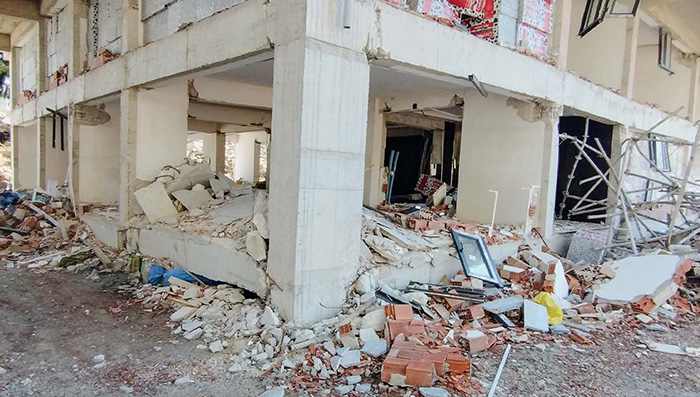Devastating Damage

Structural engineering team recounts reconnaissance visit to Turkey following massive earthquakes
Fatih Canakci was only 3 years old in August 1999 when a catastrophic earthquake of magnitude 7.6 struck the Kocaeli Province of Turkey, causing monumental damage and more than 17,000 deaths.
Although Canakci, now a graduate student in civil engineering, doesn’t remember much from the devastating event that impacted his family and homeland, its lingering influence motivated him to become a civil engineer and analyze the design of structures in earthquake-prone areas.
In March, Canakci was one of three graduate students, along with Lissette Iturburu and Oscar Forero, who accompanied Ayhan Irfanoglu, professor and associate head of the Lyles School of Civil Engineering, on a reconnaissance visit to assess the massive damage from back-to-back 7.8 and 7.5 magnitude earthquakes that struck Turkey and Syria on February 6, 2023. The group joined teams of engineers — many of whom were Purdue civil engineering alumni — supported by the American Concrete Institute.
“We landed in Gaziantep and traveled 40 miles west to reach the disaster zone where we were shocked by what we saw,” Canakci said. “Most of the buildings were heavily damaged. Some had collapsed, many of them residential structures. Understanding that more than 50,000 people died in the earthquake reinforces our critical mission as structural engineers which is to learn how structures respond to strong ground motion and determine how to build structures to withstand high levels of seismic excitation.”
Irfanoglu, who traveled to Turkey in 1999 on his own as a graduate student to observe structural damage from the Kocaeli earthquake, wanted the earthquake engineering graduate students on this trip to survey the wreckage first-hand and learn how to quickly assess the structural integrity of a building.
“When you see it with your own eyes, it’s not like a photograph,” Irfanoglu said. “You’re in the middle of it. There are some areas where the buildings are completely gone, and it requires imagination to reconstruct what happened. There’s an overwhelming sense of loss. Seeing the devastation up close makes it evident that our work directly impacts people’s lives.”
For Iturburu, a native of Ecuador — another earthquakeprone region, the experience helped focus her research direction by expanding her view on the seismic vulnerability of buildings in different communities.
“Witnessing the real-world implications of structural failures and the devastating impact on communities has solidified my commitment to pursue a career focused on resilience,” Iturburu said.
Irfanoglu credits the late Mete Sozen, the Karl H. Kettelhut Distinguished Professor of Civil Engineering, and his work on the earthquake-resistant design of reinforced concrete structures for establishing Purdue as a leading institution for earthquake engineering. Sozen developed a simple seismic vulnerability ranking method, making safe building practices easier to adopt.
A scholarship established in Sozen’s name to support students in earthquake engineering provided some of the funding for the graduate students to go on the reconnaissance trip. Part of the team’s work included assessing structures using the index Sozen developed to determine whether it could be applied to taller buildings.
“Professor Sozen dedicated his life to developing the Hassan Index,” Forero said. “During this research trip, we were able to gather valuable data for the largest dataset on this index, which is a testament to Professor Sozen’s enduring legacy. It’s exciting to be part of the next generation of engineers who will ensure that Professor Sozen’s work and contributions continue to make a significant impact in the field of earthquake engineering.”
In 2003, Irfanoglu joined Sozen and a team from Purdue — led by Professor Julio Ramirez — on a research trip to eastern Turkey following a 6.4 magnitude earthquake. It would turn out to be Sozen’s final earthquake reconnaissance trip. The things Irfanoglu learned from Sozen during that week changed his perspective as an engineer.
“I hope to convey the same knowledge to my students that Sozen instilled in me,” Irfanoglu said. “Once you get to that level of understanding, you can work faster and visualize how damage develops. Sozen espoused a belief to keep things simple so that in the face of uncertainty we can make the right decisions without sacrificing lives or property.”
For years after he witnessed the aftermath of the ’99 earthquakes, Irfanoglu would close his eyes and walk the streets again and again in his mind. Now, scenes from the ’23 earthquakes occupy his thoughts.
“Sadly, there will be more disasters like this around the world,” Irfanoglu said. “We know the solutions and they are neither complicated nor that costly. We hope that by speaking up and sharing our observations, designers and builders will do the right thing and construct robust buildings."

The Professor Mete A. Sozen Fund
To support the Professor Mete A. Sozen Fund for students interested in earthquake engineering,
contact Eric Putman, chief development officer, at 765-494-2236 or eaputman@purdueforlife.org.
